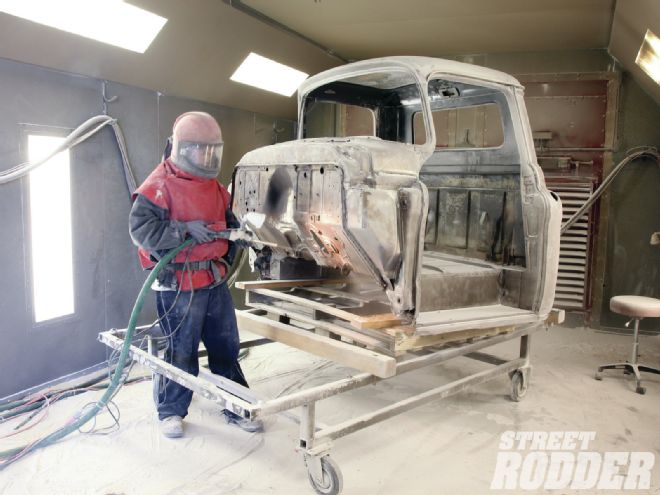
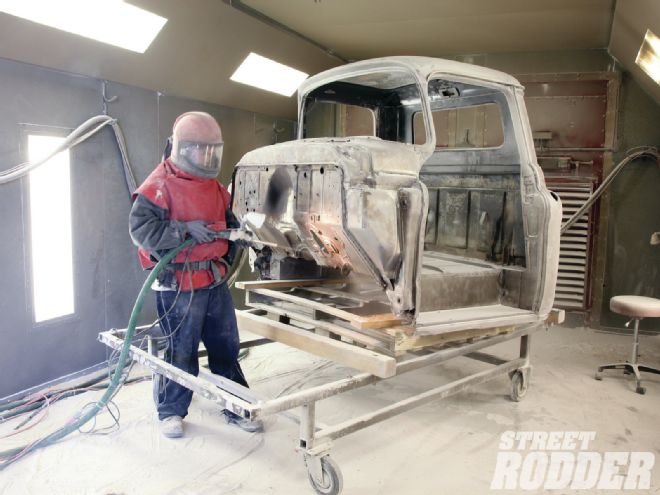
The media used in soda blasting, sodium bicarbonate, has been around forever, and its uses are widely varied. Not only is it the soothing ingredient found in mineral springs, but another form, baking soda, has many uses in the kitchen and around the house. When workers were trying to figure out what could be used to remove old material from the Statue of Liberty during its restoration back in the early ’80s, a soda-based power spray not only removed the grime, but the soda was found to be essentially environmental friendly.
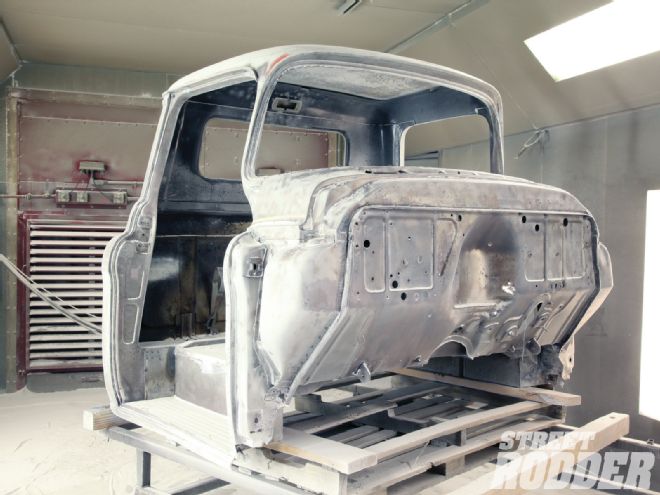 Blasting paint, or anything else short of rust, can be blasted off a surface with soda bicarbonate. It works well on items made from fiberglass and, because there isn’t any heat generated when using the product, it won’t lead to warpage when blasting aluminum or steel.
Blasting paint, or anything else short of rust, can be blasted off a surface with soda bicarbonate. It works well on items made from fiberglass and, because there isn’t any heat generated when using the product, it won’t lead to warpage when blasting aluminum or steel.
Over the past couple of decades, soda blasting has become popular with the automotive crowd because of its ease of use as well as spectacular results, but it was not without its rumors, most of which are unfounded. When STREET RODDER wanted to have a new build frame blasted before it was to be powdercoated, the magazine contacted Cal Blast in Upland, California. The De Albas, a father and son team both with the first name Albert, have owned Cal Blast for years, with Dad having spent the previous two decades in the automotive restoration and repair business.
Albert Sr. has several years experience in soda blasting, and finds it’s the best way to give customers a clean and perfect surface before body and paintwork begins. There are only two real downsides to soda blasting, but Cal Blast has a good answer to both. Some folks don’t know they have to wash the surface of their blasted item with soap and water after soda blasting due to the light film of slippery dust that is left, but most items going through Cal Blast have a secondary blast of copper shot, which removes any leftover soda media. Albert Sr. has heard stories about paint popping off material that had been blasted with soda, but he believes it was a problem with the prep and not getting all the dust off the item before it was primed. Soda blasting won’t remove rust, either, but Cal Blast uses the copper shot after the soda just for that purpose, and it removes all rust. The result is not only a rust-free part, but the copper removes the leftover soda dust, too. And, to further help their clients, Cal Blast not only blasts products with both soda and copper, but it also offers priming services, so your project can sit around in your garage without any surface rust reappearing weeks later. Another advantage in blasting with soda is if you’re working on a car body you can roll it into the booth with the glass and trim still on it and the soda won’t harm either. And soda won’t harm aluminum, steel, or fiberglass.
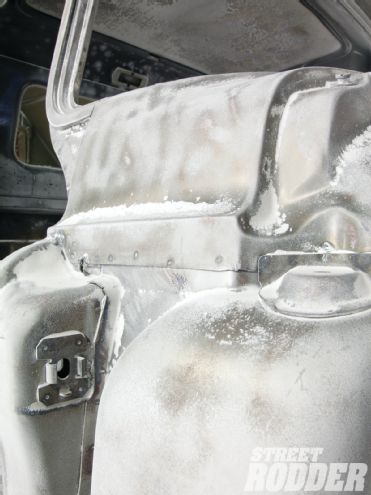 Up close, you can see the steel cab was given a smooth finish after soda blasting. The product does leave a powdery film after blasting, and it should be cleaned with soap and water before any body or paintwork begins.
Up close, you can see the steel cab was given a smooth finish after soda blasting. The product does leave a powdery film after blasting, and it should be cleaned with soap and water before any body or paintwork begins.
Over the years there have been many different types of blasting media used—each with its benefits and pitfalls. Blasting with sand is probably the most well known, and is also the most well-known for the damage it can cause when mishandled. The air pressure used to project the sand through a gun is high enough so when the media hits the metal, it generates heat, and the chances of warping large-panel areas (such as hoods, roofs, or doors) can be high. The dust generated with sand blasting can be hazardous to those working with it, too, though the material itself is fairly cheap to use. Other medias used in blasting, plastic chips (think ground-up Legos) and walnut shells (which can leave a natural oil on the surface), can be reused a few more times before they lose their paint-cutting qualities, and that might be the one downside to soda blasting: it can only be used once. As Albert Sr. likes to say: “It starts out like salt and ends up like flour.”
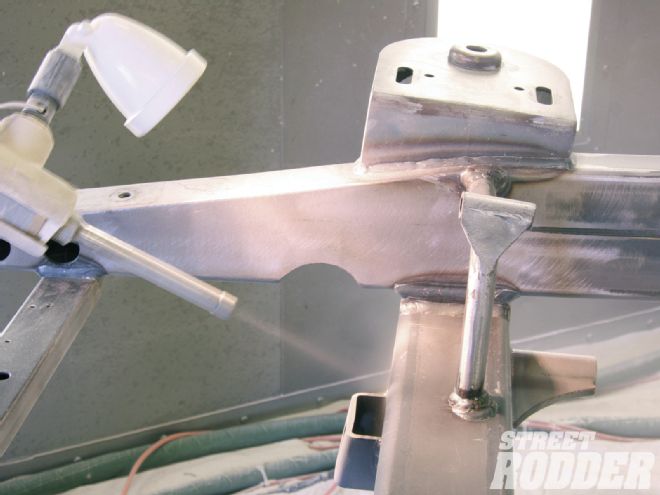 The soda comes out of the tip of the gun at about 100 psi. Albert Jr. says the texture of the soda “starts out like table salt, but ends up like flour” after being pulverized.
The soda comes out of the tip of the gun at about 100 psi. Albert Jr. says the texture of the soda “starts out like table salt, but ends up like flour” after being pulverized.
But getting material off parts and pieces is only half the battle. The second part to a good foundation is what you do next with the parts. For years people have painted suspension parts, chassis, and wheels, but powdercoating these items is becoming more and more popular. Most folk’s first encounter with powdercoating is the finish found on their lawn furniture—very strong and nearly impossible to get off. Back in the day, when powdercoating was first being used for automotive applications, you would find only basic colors. But times have changed, and now nearly any color in the rainbow can be custom mixed, and can come in flat, or semi- and high-gloss finishes. Wrinkle and hammer tone finishes are also available.
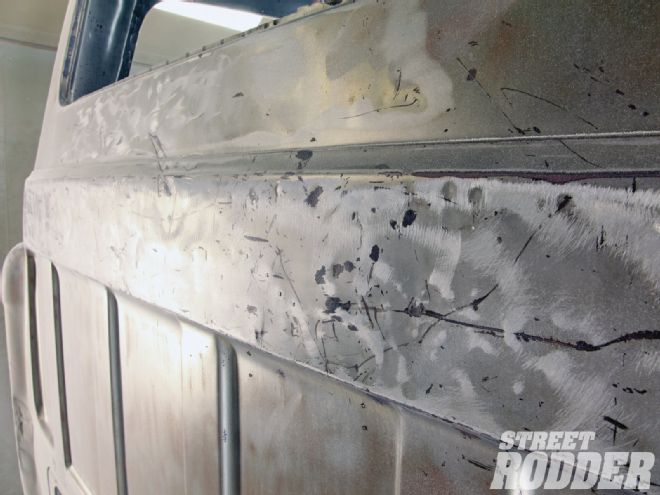 The back of this truck cab had a fair amount of body filler covering the dents, and the soda blast took it right off. The long brown scratches in the body are actually rust spots that have been there for years. Cal Blast follows their soda blast with a copper blast (using copper shot), which removes any and all rust.
The back of this truck cab had a fair amount of body filler covering the dents, and the soda blast took it right off. The long brown scratches in the body are actually rust spots that have been there for years. Cal Blast follows their soda blast with a copper blast (using copper shot), which removes any and all rust.
After this truck frame and miscellaneous trim pieces were soda and copper blasted at Cal Blast, they were delivered to Fusioncoat, a powdercoating company owned by Eddie Borges (of Eddie Marine/Motorsport fame) based in Rancho Cucamonga, California. Fusioncoat has been around since 1997 and they have coated everything from car wheels to suspension parts, engine parts and air cleaners, and everything else in between. And where anodizing is a plating process where a dye is added to create a color, powdercoating is accomplished by negatively grounding the item to be coated, then positively charging a powder media that gets shot through a gun at low pressure and, when it hits the negatively grounded part, the powder sticks. What’s more, Fusioncoat can also do two-stage powdercoating that gives the finish a pearlized or candied appearance.
To start the process, parts are wired to an aluminum foil-wrapped rack. The foil is used for two reasons: conductivity, and ease of removal after being covered with overspray from the powdercoating. Fusioncoat’s Toby Martinez, who has been powdercoating for more than 20 years, then fills a hopper with powdercoating media, which resembles colored baby powder.
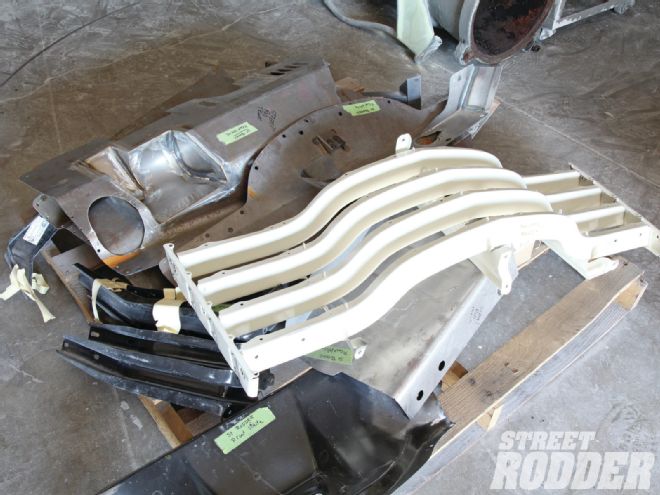 All of these parts, including the grille, fender braces, inner fender panels, and more will be soda blasted. It’s a great way to clean up metal if it’s new, or remove old paint if it’s old.
All of these parts, including the grille, fender braces, inner fender panels, and more will be soda blasted. It’s a great way to clean up metal if it’s new, or remove old paint if it’s old.
He sprays the parts with the powdered media until everything has a light, even coat. From there the parts are put into a large baking oven, which is set at 400 degrees F. Depending on the thickness of the material coated, the parts and pieces will stay in the oven anywhere from 15 to 30 minutes and, after they are removed and cooled, have a perfectly even finish in the color and gloss level chosen. Plus chances are you’ll dent the part before you’ll ever be able to scratch or chip something that has been coated by Fusioncoat.